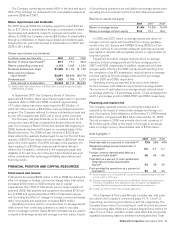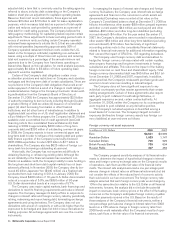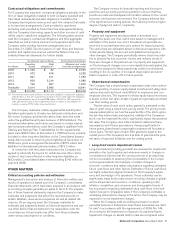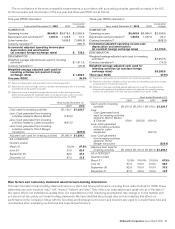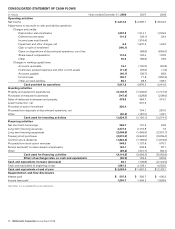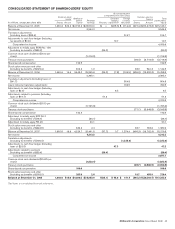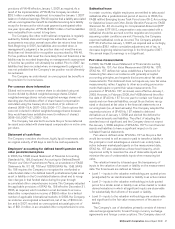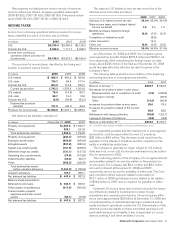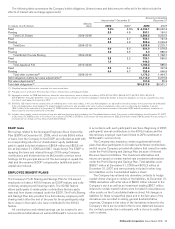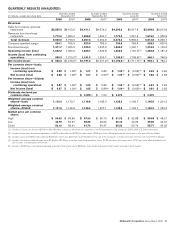McDonalds 2008 Annual Report Download - page 47
Download and view the complete annual report
Please find page 47 of the 2008 McDonalds annual report below. You can navigate through the pages in the report by either clicking on the pages listed below, or by using the keyword search tool below to find specific information within the annual report.
Property and equipment
Property and equipment are stated at cost, with depreciation and
amortization provided using the straight-line method over the fol-
lowing estimated useful lives: buildings–up to 40 years; leasehold
improvements–the lesser of useful lives of assets or lease terms,
which generally include option periods; and equipment–three to 12
years.
Goodwill
Goodwill represents the excess of cost over the net tangible
assets and identifiable intangible assets of acquired restaurant
businesses. The Company’s goodwill primarily results from pur-
chases of McDonald’s restaurants from franchisees and ownership
increases in international subsidiaries or affiliates, and it is gen-
erally assigned to the reporting unit expected to benefit from the
synergies of the combination. If a Company-operated restaurant is
sold within 24 months of acquisition, the goodwill associated with
the acquisition is written off in its entirety. If a restaurant is sold
beyond 24 months from the acquisition, the amount of goodwill
written off is based on the relative fair value of the business sold
compared to the portion of the reporting unit (defined as each
individual country).
In accordance with Statement of Financial Accounting Stan-
dards No. 142, Goodwill and Intangible Assets, the annual goodwill
impairment test, conducted in the fourth quarter, compares the fair
value of a reporting unit, generally based on discounted future
cash flows, with its carrying amount including goodwill. If the carry-
ing amount of a reporting unit exceeds its fair value, an impairment
loss is measured as the difference between the implied fair value
of the reporting unit’s goodwill and the carrying amount of good-
will.
The following table presents the 2008 activity in goodwill by
segment:
In millions U.S. Europe APMEA(1) Other Countries
& Corporate(2) Consolidated
Balance at December 31, 2007 $1,146.5 $700.2 $306.1 $148.5 $2,301.3
Net restaurant purchases (sales) 3.2 53.2 4.9 (2.4) 58.9
Ownership increases in subsidiaries/affiliates 10.1 10.1
Currency translation (71.5) (34.3) (27.1) (132.9)
Balance at December 31, 2008 $1,149.7 $692.0 $276.7 $119.0 $2,237.4
(1) APMEA represents Asia/Pacific, Middle East and Africa.
(2) Other Countries & Corporate represents Canada, Latin America and Corporate.
Long-lived assets
In accordance with Statement of Financial Accounting Standards
No. 144, Accounting for the Impairment or Disposal of Long-Lived
Assets (SFAS No. 144), long-lived assets are reviewed for impair-
ment annually in the fourth quarter and whenever events or
changes in circumstances indicate that the carrying amount of an
asset may not be recoverable. For purposes of annually reviewing
McDonald’s restaurant assets for potential impairment, assets are
initially grouped together at a television market level in the U.S. and
at a country level for each of the international markets. The Com-
pany manages its restaurants as a group or portfolio with
significant common costs and promotional activities; as such, an
individual restaurant’s cash flows are not generally independent of
the cash flows of others in a market. If an indicator of impairment
(e.g., negative operating cash flows for the most recent trailing
24-month period) exists for any grouping of assets, an estimate of
undiscounted future cash flows produced by each individual
restaurant within the asset grouping is compared to its carrying
value. If an individual restaurant is determined to be impaired, the
loss is measured by the excess of the carrying amount of the res-
taurant over its fair value as determined by an estimate of
discounted future cash flows.
Losses on assets held for disposal are recognized when man-
agement and the Board of Directors, as required, have approved
and committed to a plan to dispose of the assets, the assets are
available for disposal, the disposal is probable of occurring within
12 months, and the net sales proceeds are expected to be less
than its net book value, among other factors. Generally, such
losses relate to restaurants that have closed and ceased oper-
ations as well as other assets that meet the criteria to be
considered “available for sale” in accordance with SFAS No. 144.
When the Company sells an existing business to a devel-
opmental licensee, the licensee purchases the business, including
the real estate, and uses his/her capital and local knowledge to
build the McDonald’s Brand and optimize sales and profitability
over the long term. The sale of the business includes primarily land,
buildings and improvements, and equipment, along with the fran-
chising and leasing rights under existing agreements. Under the
related developmental licensing arrangement, the Company col-
lects a royalty based on a percent of sales, as well as initial fees,
but does not have either any capital invested in the business or any
commitment to invest future capital.
An impairment charge is recognized for the difference between
the net book value of the business (including any foreign currency
translation adjustments recorded in accumulated other compre-
hensive income in shareholders’ equity) and the estimated cash
sales price, less costs of disposal.
The Company bases its accounting policy on management’s
determination that royalties payable under its developmental
license arrangements are substantially consistent with market
rates for similar license arrangements. Therefore, the Company
believes that the recognition of an impairment charge based on the
net cash sales price reflects the substance of the sale transaction.
Financial instruments
The Company generally borrows on a long-term basis and is
exposed to the impact of interest rate changes and foreign cur-
rency fluctuations. The Company uses foreign currency
denominated debt and derivative instruments to mitigate the impact
of these changes. The Company does not use derivatives with a
level of complexity or with a risk higher than the exposures to be
McDonald’s Corporation Annual Report 2008 45


